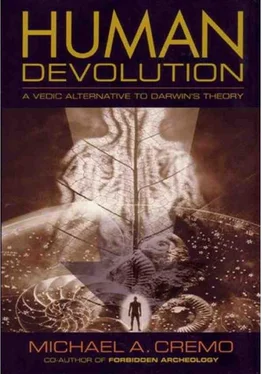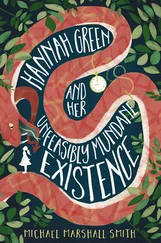Michael Cremo - Human Devolution - A Vedic Alternative To Darwin's Theory
Здесь есть возможность читать онлайн «Michael Cremo - Human Devolution - A Vedic Alternative To Darwin's Theory» весь текст электронной книги совершенно бесплатно (целиком полную версию без сокращений). В некоторых случаях можно слушать аудио, скачать через торрент в формате fb2 и присутствует краткое содержание. Год выпуска: 2003, ISBN: 2003, Издательство: Torchlight Publishing, Жанр: Старинная литература, на английском языке. Описание произведения, (предисловие) а так же отзывы посетителей доступны на портале библиотеки ЛибКат.
- Название:Human Devolution: A Vedic Alternative To Darwin's Theory
- Автор:
- Издательство:Torchlight Publishing
- Жанр:
- Год:2003
- ISBN:9780892133345
- Рейтинг книги:4 / 5. Голосов: 1
-
Избранное:Добавить в избранное
- Отзывы:
-
Ваша оценка:
- 80
- 1
- 2
- 3
- 4
- 5
Human Devolution: A Vedic Alternative To Darwin's Theory: краткое содержание, описание и аннотация
Предлагаем к чтению аннотацию, описание, краткое содержание или предисловие (зависит от того, что написал сам автор книги «Human Devolution: A Vedic Alternative To Darwin's Theory»). Если вы не нашли необходимую информацию о книге — напишите в комментариях, мы постараемся отыскать её.
Human Devolution: A Vedic Alternative To Darwin's Theory — читать онлайн бесплатно полную книгу (весь текст) целиком
Ниже представлен текст книги, разбитый по страницам. Система сохранения места последней прочитанной страницы, позволяет с удобством читать онлайн бесплатно книгу «Human Devolution: A Vedic Alternative To Darwin's Theory», без необходимости каждый раз заново искать на чём Вы остановились. Поставьте закладку, и сможете в любой момент перейти на страницу, на которой закончили чтение.
Интервал:
Закладка:
In late 2001, Meave Leakey introduced even more confusion into an already confused picture. She announced in nature (Leakey et al . 2001) the discovery of a new hominid. Leakey and her colleagues found a nearly complete skull of the creature in August of 1999, near Lake Turkana, in Kenya. The creature is 3.5 million years old, roughly the same age as Australopithecus afarensis . Instead of identifying her find as a new member of the genus Australopithecus, Meave Leakey stirred up the hominid world by creating a new genus and species for it: Kenyanthropus platyops. The name is significant. Anthropus means “human” whereas pithecus means “ape.” So Leakey was obviously putting Kenyanthropus platyops in the human line, implying that Australopithecus is nothing more than an extinct ape, unrelated to humans. Leakey suggested that Kenyanthropus platyops might be linked to later fossils currently attributed to Homo rudolfensis. Although Meave Leakey called for further research, it appeared she was positioning Kenyanthropus platyops so as to permanently remove the australopithecines from the line of human ancestry. My reply is that neither Kenyanthropus nor Australopithecus are human ancestors because there is evidence that anatomically modern humans existed alongside them and before them.
In short, the picture of newly discovered early hominids is quite confusing and contradictory. In all these cases, scientists are speculating about fragmentary fossil remains, seeing in them human ancestors, when they most likely are simply varieties of apes with some few features in common with modern humans. These features are, however, not necessarily signs of an evolutionary connection.
Despite the confusion surrounding Australopithecus, many scientists still accept this creature as a direct human ancestor. The first specimen of Australopithecus was discovered in 1924 by Dr. Raymond Dart in South Africa. Dart believed it was the earliest human ancestor, but most of the influential scientists of his time thought it was just a variety of ape. It was not until the late 1950s that Australopithecus won general acceptance as a human ancestor. But there remained important scientists who did not agree. Among these scientists were Louis Leakey, one of the most famous anthropologists of the twentieth century. Meave Leakey’s interpretation of her Kenyanthropus platyops as the ancestor of the Homo line, bypassing Australopithecus, can be seen as continuing Louis Leakey’s work.
Lord Zuckerman, a respected British zoologist, carried out many exacting statistical studies showing that Australopithecus was not a human ancestor. The work of Lord Zuckerman has been carried into the present by Charles E. Oxnard, now a professor of physical anthropology at the University of Western Australia. For a strong antidote to modern propaganda about the australopithecines being human ancestors, one should read his books uniqueness and Diversity in Human evolution (1975) and The order of man (1984) . These books have been largely ignored by the scientific establishment, challenging as they do one of the articles of faith of human evolution studies. But they are required reading for anyone who wants to know the truth about Australopithecus. The anatomical studies of Oxnard place Australopithecus close to the gibbons and orangutans and distant from the African apes and humans. Given this set of relationships, it is difficult to see Australopithecus as a direct human ancestor.
Scientists who believe Australopithecus is a human ancestor see in its fossil bones signs of upright walking ability and other human features. But Oxnard’s studies show a creature just as likely to be found swinging through the trees like a gibbon or orangutan as walking upright on the ground.
Even among scientists who do accept Australopithecus as a human ancestor, there is a great deal of disagreement. On one side, we have Donald Johanson, and his colleagues and supporters, who believe that the australopithecines walked upright on the ground just like modern humans. This would, according to this group, be especially true of Lucy, the specimen of Australopithecus afarensis that Johanson himself discovered in Ethiopia during the 1970s (Johanson and Edey 1981). But Johanson’s critics, and there are many, say that the long curved fingers and toes of Lucy and her relatives, along with many other anatomical features, show that these creatures spent a lot of time in trees (Stern and Susman
1983, pp. 282–284; Susman et al . 1984, p 117; Marzke 1983, p. 198). Here they would be in agreement with Oxnard. Some scientists think that Johanson and his coworkers have mistakenly combined the fossils of two or three kinds of creatures into the single species Australopithecus afarensis.
During the 1970s, Johanson put forward the idea that Lucy was the oldest known human ancestor, and that starting with her all the other hominids could be arranged in a definite evolutionary progression. The several species could be arranged in two branches coming from the trunk of Australopithecus afarensis. One branch would be composed of the Homo habilis, Homo erectus, and then Homo sapiens. On the second branch would be the remaining australopithecines. First comes Australopithecus africanus, then Australopithecus robustus, then Australopithecus boisei. The trend among these is toward greater robustness . In 1985, the Black Skull, designated Australopithecus garhi, was discovered. This was a robust australopithecine specimen even more robust than A. boisei. If the Black Skull had been younger than A. robustus and A. boisei , there would have been no problem. It would have fit nicely into the progression of robust australopithecines. But instead the Black Skull was older than the oldest specimens of A. robustus. This completely messed up the neat little diagram drawn by Johanson.
As it stands now, there is no agreement at all about the relationships between the various species of Australopithecus. As physical anthropologist Pat Shipman (1986, p. 92) put it, “The best answer we can give right now is that we no longer have a very clear idea of who gave rise to whom.” Shipman said that in 1986, but the situation has not changed much since then. In fact, the situation has become even more complicated with the addition of discoveries of new species of Australopithecus such as Australopithecus anamensis and Australopithecus aethiopicus. The confusion extends not only to the evolutionary relationships among the australopithecines but also to the relationship between Australopithecus and Homo habilis, the first member the genus to which modern humans belong. Shipman, considering all the alternatives, said, “We could assert that we have no evidence whatsoever of where Homo arises from and remove all members of the genus Austra-lopithecus from the hominid family.” In other words, Australopithecus is not a human ancestor, which is exactly what Zuckerman and Oxnard have always said. But Shipman hesitated, noting, “I’ve such a visceral negative reaction to this idea that I suspect I am unable to evaluate it rationally. I was brought up on the notion that Australopithecus is a hominid” (Shipman 1986, p. 93).
And here is one more problem with Australopithecus— mainstream scientists say Australopithecus lived only in Africa. But other scientists have reported australopithecines from China, Indonesia, and Southeast Asia (Robinson 1953, Jian et al. 1975, Franzen 1985, and Chen 1990). If accepted, this would make a mess of most current schemes of hominid evolution, making an Asian origin for the hominids as likely as an African origin.
Читать дальшеИнтервал:
Закладка:
Похожие книги на «Human Devolution: A Vedic Alternative To Darwin's Theory»
Представляем Вашему вниманию похожие книги на «Human Devolution: A Vedic Alternative To Darwin's Theory» списком для выбора. Мы отобрали схожую по названию и смыслу литературу в надежде предоставить читателям больше вариантов отыскать новые, интересные, ещё непрочитанные произведения.
Обсуждение, отзывы о книге «Human Devolution: A Vedic Alternative To Darwin's Theory» и просто собственные мнения читателей. Оставьте ваши комментарии, напишите, что Вы думаете о произведении, его смысле или главных героях. Укажите что конкретно понравилось, а что нет, и почему Вы так считаете.












